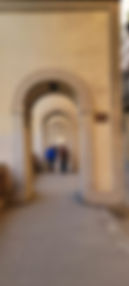Underground Mysteries of Florence: Delving into the Hidden Depths of the Renaissance City
Updated: Sep 16, 2024

Countless visitors stroll through Florence's cobblestone streets, often unaware of the city’s hidden underground layers. This Renaissance cradle, a hub for world-renowned art and architecture, also harbors historical secrets beneath its surface.
Many are surprised to learn about Florence's tunnels, catacombs, and ancient ruins under its lively streets. These hidden elements add to the city's charm for those who seek a deeper understanding. Join us in exploring the subterranean wonders of this Italian treasure.

1. The Vasari Corridor
The Vasari Corridor, partially above ground, remains one of Florence’s intriguing secrets. Cosimo I de' Medici commissioned this 16th-century walkway connecting the Palazzo Vecchio, the Uffizi Gallery, and the Palazzo Pitti. This architectural marvel by Giorgio Vasari offered the Medici family a secure passage between homes, featuring views of the city and hidden escape routes. Vasari Corridor

2. Crypt of Santa Reparata
Under the Florence Cathedral (Duomo) lies the crypt of Santa Reparata, the earlier cathedral on this site. Unearthed after 50 years of excavation, this crypt displays ancient pavements, Florentine tombstones, and remnants dating back to Roman times, offering a glimpse into Florence's layered past. Crypt of Santa Reparata

3. Bunker of Villa Torrigiani
Florence's wartime history includes the bunker under Villa Torrigiani, built during Mussolini's fascist regime to shelter city leaders from air raids. This bunker, now a symbol of resilience, reflects a chapter of Florence's history beyond the Renaissance.
4. Florence’s Ancient Roman Theater
Beneath the streets around Palazzo Vecchio lies a Roman theater, a testament to Florence’s ancient Roman era. Once seating 15,000, this theater was active from the 1st to 3rd centuries AD, later forgotten and rediscovered in the late 19th century.
5. The Old Mills of Florence
The Arno River once powered Florence’s ancient mills, crucial to the city’s medieval economy. These mills, hidden under modern buildings, played a vital role in the city’s past.

6. The Crypt of San Niccolò
Below the San Niccolò tower is a crypt from the 1300s, shrouded in legend. Rumored to be part of a secret tunnel network, this crypt symbolizes Florence's mysterious past.
7. The Orsanmichele Church
The Orsanmichele Church, originally a 9th-century grain market, transformed into a church by the 14th century. Its lower level reveals the market's remains, showcasing Florence's architectural evolution.


8. San Marco Convent
San Marco Convent holds many secrets that make it a hidden gem in Florence’s rich history. Behind its unassuming walls lies a world of Renaissance intrigue, from the personal cells of monks adorned with Fra Angelico’s deeply spiritual frescoes to the political and religious turmoil that once echoed through its halls. One of the most fascinating secrets is the influence of Cosimo de’ Medici, who funded the convent's construction and had his own private retreat there, a quiet cell where he could reflect away from the pressures of ruling Florence. Another intriguing figure is the fiery preacher Girolamo Savonarola, who resided at San Marco and later became a controversial figure in the city’s history. His passionate sermons, which eventually led to his downfall, are part of the complex story of faith, power, and art that defines the convent.
Final Thoughts
Florence's underground wonders reveal another dimension to this captivating city. To fully appreciate Florence, one must explore not only its visible marvels but also its hidden depths. As you wander through Florence, remember the secret world beneath, each element narrating a piece of the city’s rich history.
